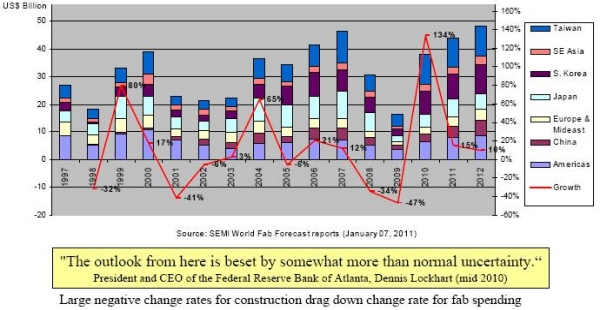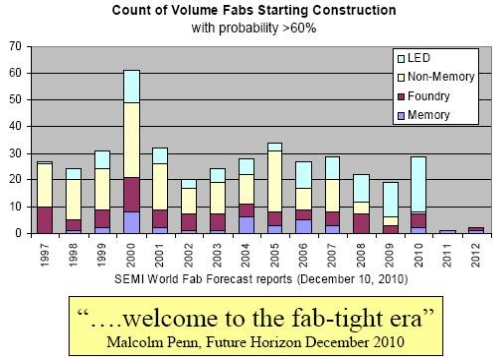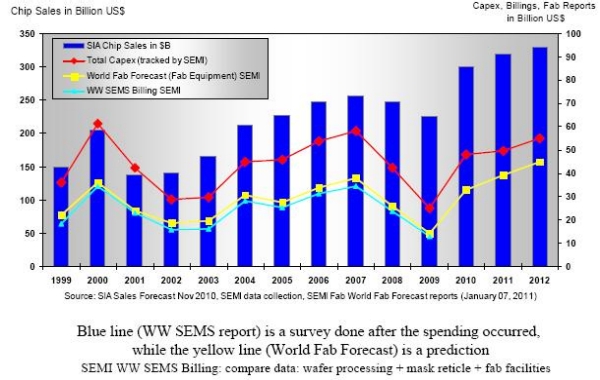by Michael A. Fury, Techcet Group
April 26, 2011 – The MRS Spring 2011 meeting is officially open in Moscone West in San Francisco. Fifty-one technical symposia will run concurrently, with over 5000 paid attendees from 50 countries, 3100 oral papers, 1700 posters, 122 exhibitors, and 14,600 entries in the authors’ directory. This author list is comparable to the total MRS membership of ~15,100.
 The opening day of this week-long meeting (Monday 4/25) consisted of nine tutorial sessions related to specific symposia topics, and a light load of two technical symposia that were scheduled to get an early jump on the week. Tutorial topics included phase-change materials, NV RAM, compound semiconductors for energy applications, and two sessions related to PV.
The opening day of this week-long meeting (Monday 4/25) consisted of nine tutorial sessions related to specific symposia topics, and a light load of two technical symposia that were scheduled to get an early jump on the week. Tutorial topics included phase-change materials, NV RAM, compound semiconductors for energy applications, and two sessions related to PV.
A few additional fun facts: running a symposium of this nature requires 38,000 chairs. If we were standing, we probably would not need as much coffee to stay alert — the attendees will consume about 1000 gallons of coffee over five days, for which the MRS will pay the Moscone Center ~$100,000. At $100 per gallon, it is little wonder that the Moscone staff ends the coffee breaks at the appointed time with ruthless efficiency. It also puts the price of gasoline into perspective.
(Additional presentation details can be found online on the MRS Spring 2011 abstracts page. The underscored codes at the beginning of papers reviewed below refer to the symposium, session and paper number.)
OO2.3: Michael Gwinner of the U. of Cambridge presented work on novel light-emitting FETs (LEFETs) which use a 20-30nm thick film of solution processable ZnO or InZnO to lower the electron injection barrier between the Au electrodes and the poly(9,9-dioctylfluorene-alt-benzothiadiazole) (F8BT) channel. This results in an increase in two orders of magnitude in the ambipolar current, and therefore in the light intensity. A blue emitting device was similarly shown with a poly(9,9-dioctylfluorene) (F8) channel.
OO2.4: Jana Zaumseil from U. Erlangen-Nuremberg studied the effect of selectively dispersed single-walled nanotubes (SWNT) in semiconducting polyfluorenes in collaboration with the Cambridge work cited above. Charge injection into the F8BT and F8 was significantly enhanced, even at low concentrations of SWNT. The structures proposed could lead to novel optoelectronic devices operating efficiently in the near-infrared telecommunication wavelength window.
WW2.1: Darrell Schlom of Cornell has apparently found a way around the high point defect levels associated with BaxSr1-xTiO3 films that are formulated for high tunability at microwave frequencies. Such films are desired to exploit the paraelectric-to-ferroelectric transition that occurs just below ambient temperatures. Schlom found that altering layers of SrO and TiO2, with the periodic injection of a double layer of SrO, results in planar defects rather than point defects. Further, biaxial tension induced by lattice mismatch from a judicious choice of substrate results in ferroelectric films. Layering thus provides an additional degree of freedom to tune the ferroelectric properties of materials. This approach is available only to thin films, not to bulk materials. One of his layered compositions, Sr7Ti6O19, has the highest ferroelectric figure of merit of any known material.
OO3.2: Franky So from the U. of Florida fabricated a high-efficiency white OLED device by constructing a blue OLED in a tunable microcavity and capturing the emission with a red-yellow phosphor mix, and further enhancing the efficiency with a macrolens. The net effect is to convert a 68 lm/W blue structure to a 99 lm/W device with excellent white rendering.
OO3.4: N. Erickson of the U. of Minnesota demonstrated a device with a single graded organic layer that transitioned smoothly from 100% hole transmitting material at the anode to near 100% electron transmitting material and the cathode. The resulting external quantum efficiency (16.9%) and power efficiency (61 lm/W) are comparable to figures of merit for more complex multilayer structures. It was proposed that extension of the approach to red and blue emitting devices may provide a path to simple products for white electrophosphorescence.
OO4.1: E.C. Turner of Arizona State has synthesized a series of metal complexes to enhance the phosphorescence of Pt- and Pd-based emitters with Λmax in the range of 420-450nm. These materials exhibit room temperature photoluminescence efficiencies that are several orders of magnitude greater than analogous emitters. The method can be generalized to other phosphorescent complexes for enhancing their emissive properties.
WW2.8: Pankaj Sharma from the U. of Nebraska used piezoresponse force microscopy (PFM) to investigate the 3D arrangement of polarization and switching behavior of ultrathin films of poly(80% vinylidene fluoride-20% trifluoroethylene), or PVDF-TrFE. Switching studies of PVDF-TrFE nanomesas were performed as a function of bias magnitude and duration with sub-10nm spatial resolution.
OO4.6: Hans Spaeth of U. of Cincinnati reported on the operation of biopolymer-based organic light-emitting diodes (BiOLEDs) that incorporate phosphorescent emitting layers. Significant increases in brightness and efficiency have been obtained over fluorescent BiOLEDs. Natural salmon sperm DNA is one of the materials frequently used in research for photonic applications development.
Michael A. Fury, Ph.D, is senior technology analyst at Techcet Group, LLC, P.O. Box 29, Del Mar, CA 92014; e-mail [email protected].


 The opening day of this week-long meeting (Monday 4/25) consisted of nine tutorial sessions related to specific symposia topics, and a light load of two technical symposia that were scheduled to get an early jump on the week. Tutorial topics included phase-change materials, NV RAM, compound semiconductors for energy applications, and two sessions related to PV.
The opening day of this week-long meeting (Monday 4/25) consisted of nine tutorial sessions related to specific symposia topics, and a light load of two technical symposia that were scheduled to get an early jump on the week. Tutorial topics included phase-change materials, NV RAM, compound semiconductors for energy applications, and two sessions related to PV.


 Pete Singer
Pete Singer

